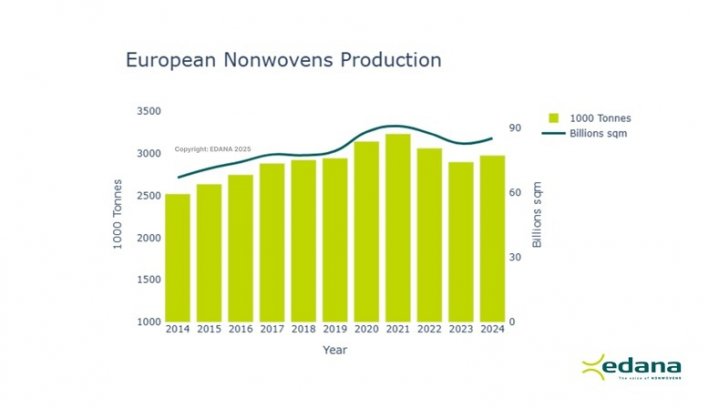
GRP is finally back on track
Strong growth in materials supplied to the building and construction and food and beverage sectors.

7th April 2025
Innovation in Textiles
|
Brussels, Belgium
Nonwovens production in Greater Europe increased in volume by 2.6% in 2024 to 2,976, 400 tons, according to Brussels-based industry association EDANA. By surface area, a 2.9% increase was achieved, with 85.1 billion square metres manufactured.
On a national level, however, there were differing trends in terms of production volume and fluctuations ins terms of the various production processes.
“In the aftermath of two consecutive annual declines of more than 5% in both 2022 and 2023, the production of nonwovens in Greater Europe has reverted to its pre-pandemic level in terms of weight,” said Jacques Prigneaux, EDANA’s market analysis and economic affairs director, “At the same time, the production in surface area grew at a faster rate, resulting in an average grammage of 34.9 gsm, as opposed to the 37.2 gsm recorded in 2019.”
These figures show that nonwovens manufacturers are continuously achieving optimised performance with lower basis weight materials.
Wetlaid nonwovens, which experienced a significant decline in 2023, demonstrated the most substantial growth rates this in 2024, while airlaid was the only web-forming process to register a decline in 2024, having been the sole process to exhibit growth in 2023.
Spunmelt production continues to dominate in terms of surface area and drylaid exhibited limited growth, attributable to the positive developments seen in the production and sales of air-through and hydroentangled materials.
The dominant end-use for nonwovens continues to be the hygiene market, accounting for 27% of deliveries, amounting to 797,300 tons and exhibiting 1.7% growth in 2024. The most substantial growth sectors for nonwovens in 2024 were building and roofing materials (+14.2%), food and beverage applications (+13%), cotton pads (+4.9%) and personal care wipes (+4.8%).
“Thanks to data collected in the two units, our statistics provide EDANA members with the opportunity to thoroughly analyze trends in tonnage and surface area across eleven production processes and at least 83 market segments,” Prigneaux said. “Without the input from participating companies these figures could have not been compiled, and we would like to thank them again for their efforts in sending their input to us. This data, combined with continuous monitoring of the industry, guarantees that EDANA statistics serve as a valuable planning and benchmarking instrument for all member companies.”
A comprehensive analysis, including deeper insights into production trends, market evolution and strategic outlooks, is available exclusively to EDANA members. This report serves as a critical resource for companies looking to navigate the evolving nonwovens landscape. In addition, in November 2024, EDANA, together with US association INDA, released the Global Nonwoven Markets Report, A Comprehensive Survey and Outlook, 2023-2028. This offers a comprehensive analysis of global nonwoven macro drivers, supply and demand trends and an expanded regional trade section. The report forecasts a steady growth in demand for nonwovens across key sectors over the next five years.

Business intelligence for the fibre, textiles and apparel industries: technologies, innovations, markets, investments, trade policy, sourcing, strategy...
Find out more